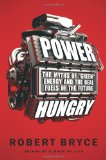Power Hungry
 |
I just finished reading a the book Power Hungry That all comes down to something pretty simple: energy density. To over-simplify a lot, how much space do you need in order to generate a given amount of energy? For things like coal, oil, natural gas, or nuclear (or for vehicles, gas), the space you need is pretty small, and you can locate the power generation capacity close to where the power is needed. For things like wind and solar, you need gobs of space, and, generally speaking, they need to be located pretty far away from where the power they generate is needed. |
And that doesn't even get into the intermittancy problem (which the author, Robert Bryce, covers in some detaiil). I've written recently about my skepticism about electric cars, and one of the more amusing parts of this book is the series of headlines about electric cars being "the future" - with that series beginning in 1901. It seems that electric vehicles have been the "wave of the future" for a long time, and the problem remains the same now as it was for Edison - battery capacity and life.
Bryce thinks the future belongs to what he calls N2N - Natural gas and nuclear - and he makes the point that if you are concerned about air pollution (either CO2, or, to me at least, the more dangerous toxins that are emitted by burning things like coal), you should favor that future as well.
That's a very brief summary of his points - like I said, Bryce marshals a lot of data in support of his conclusions. I'd recommend taking a look before you draw your own conclusions. I think he makes a ton of sense.




